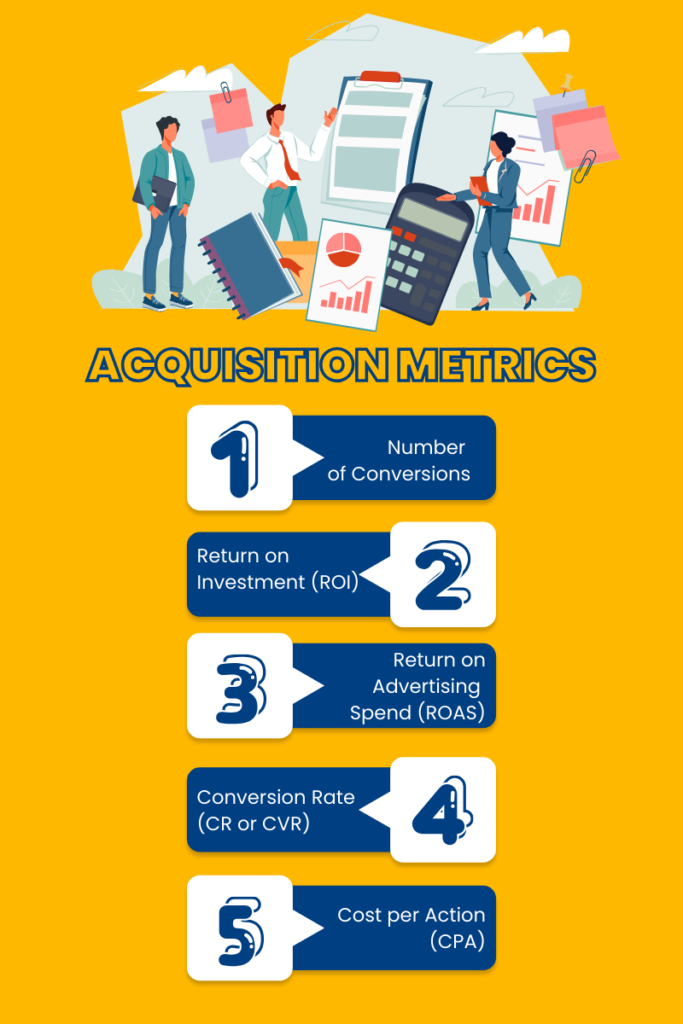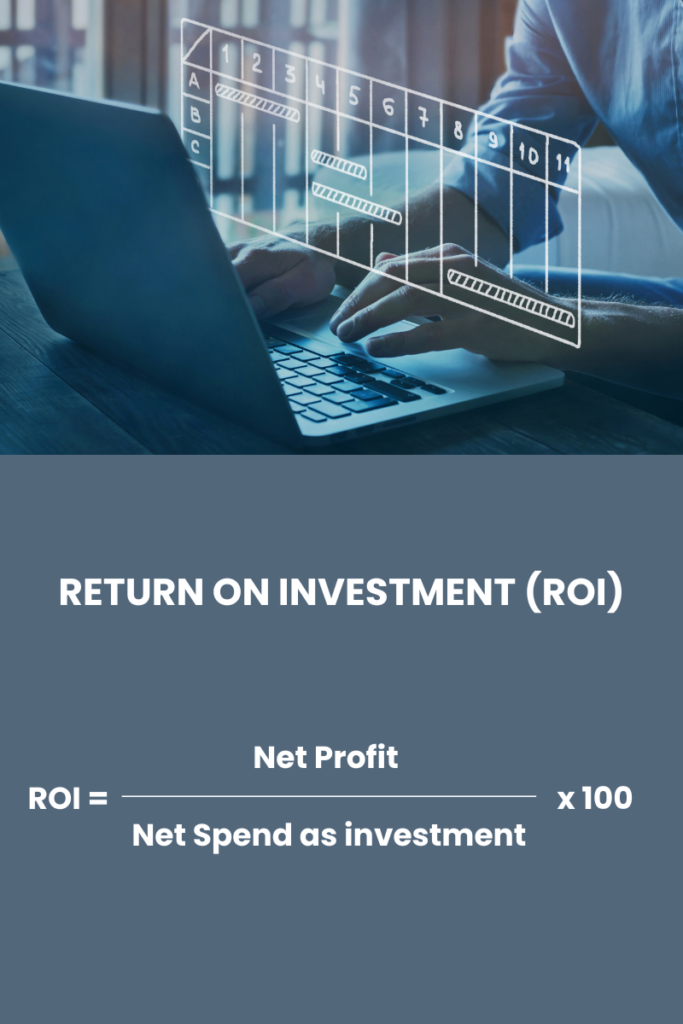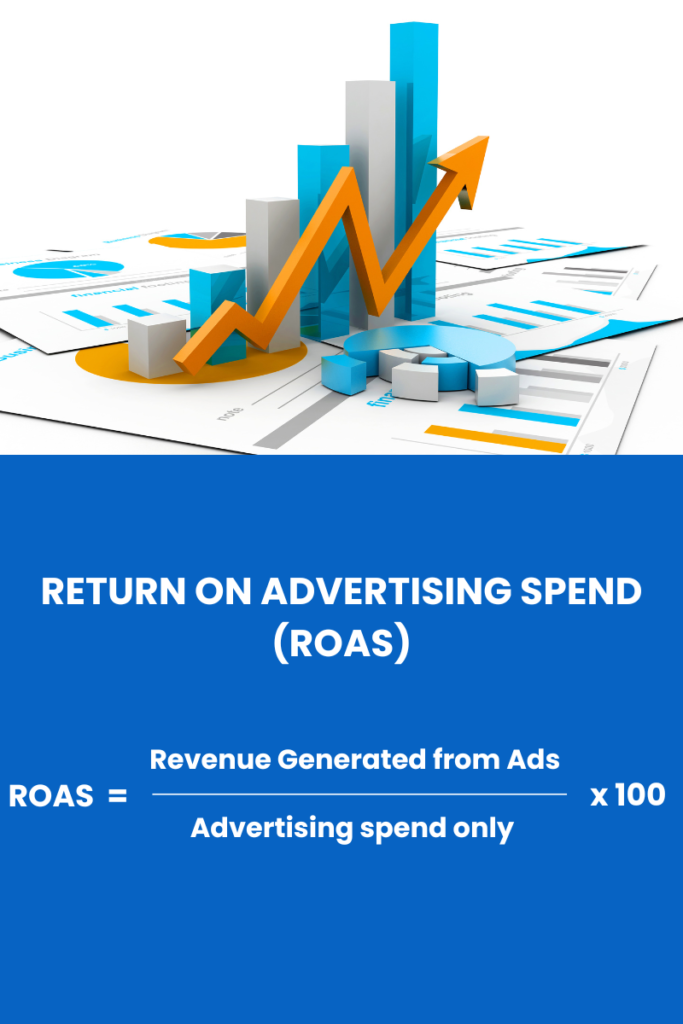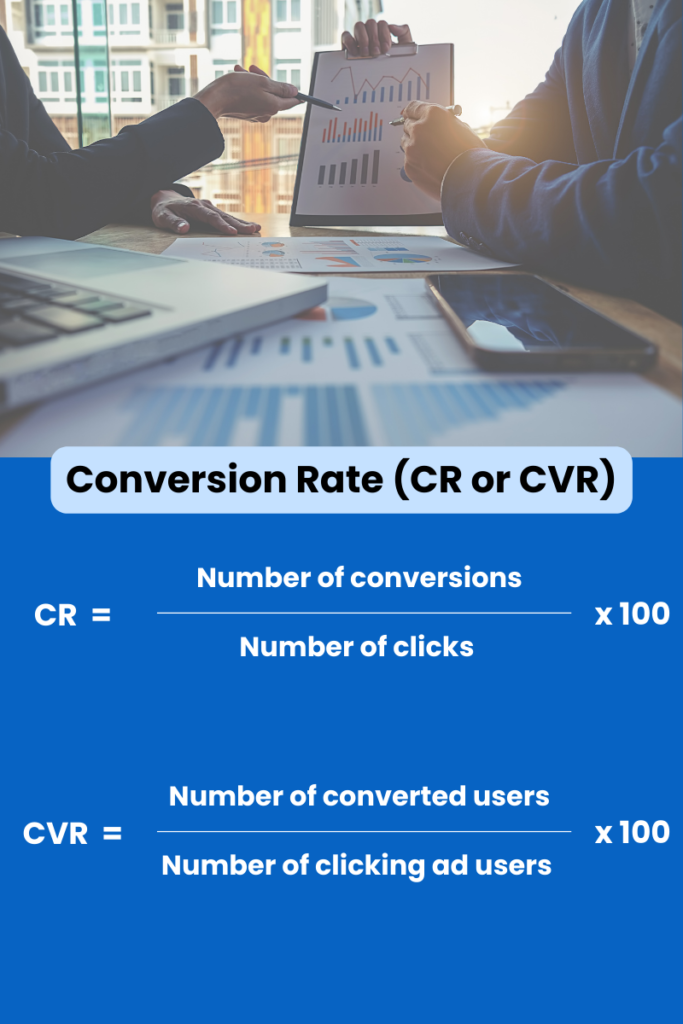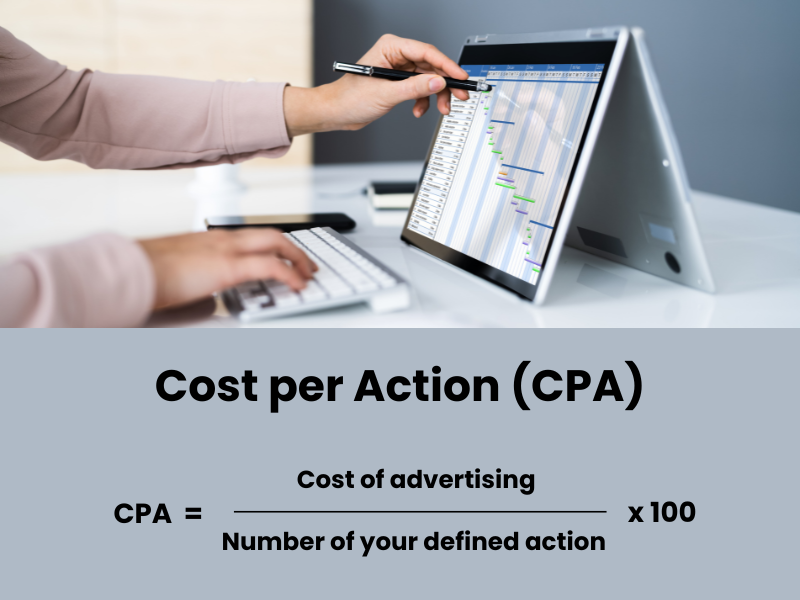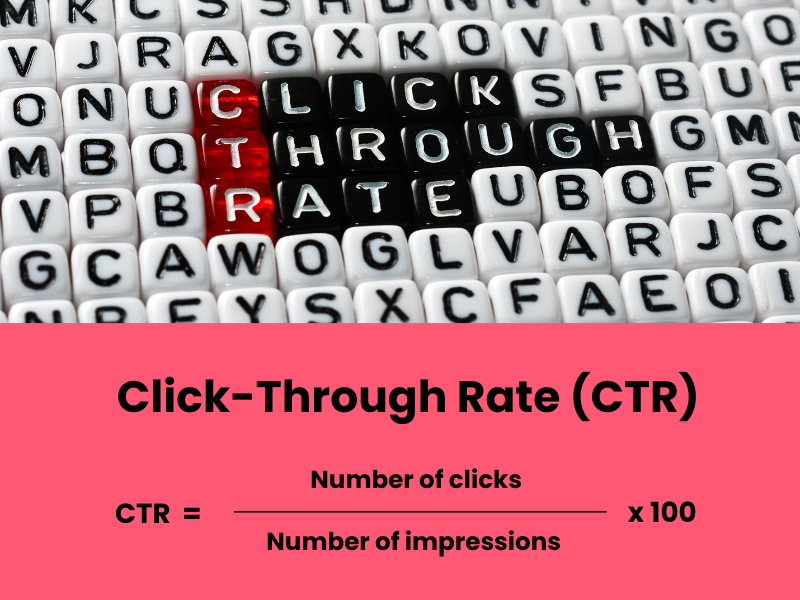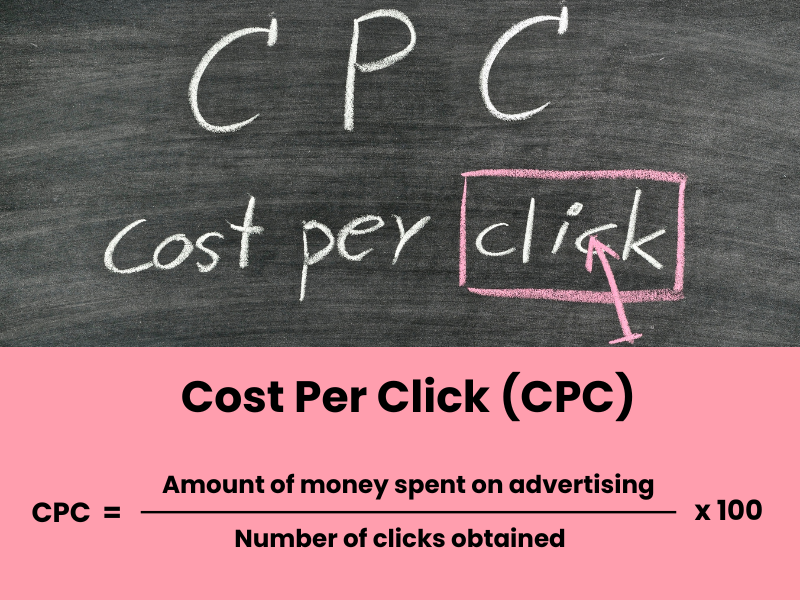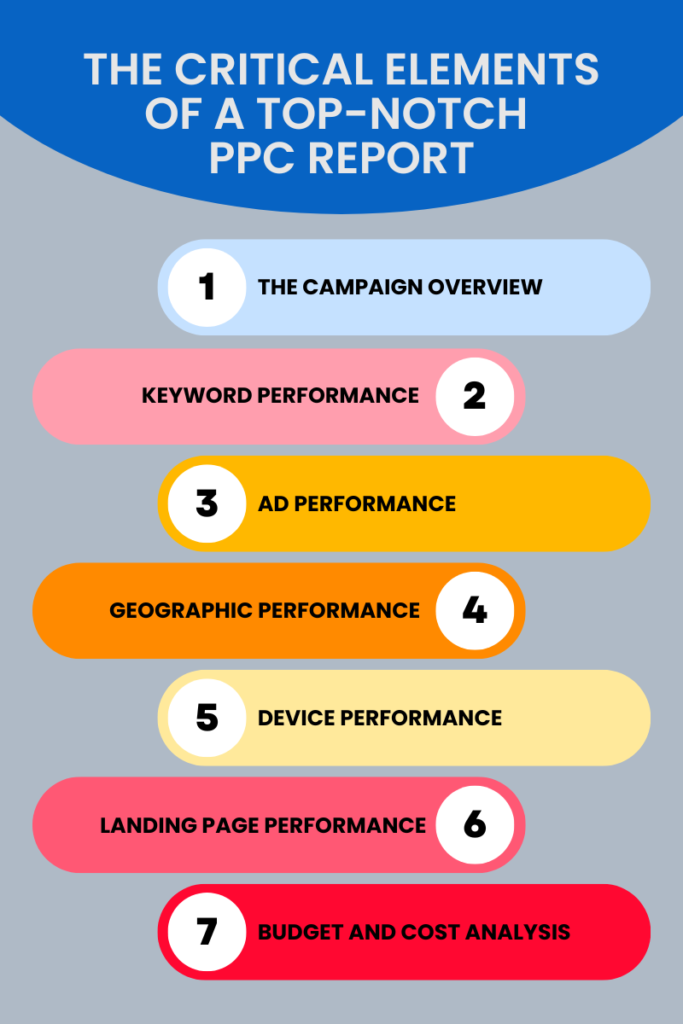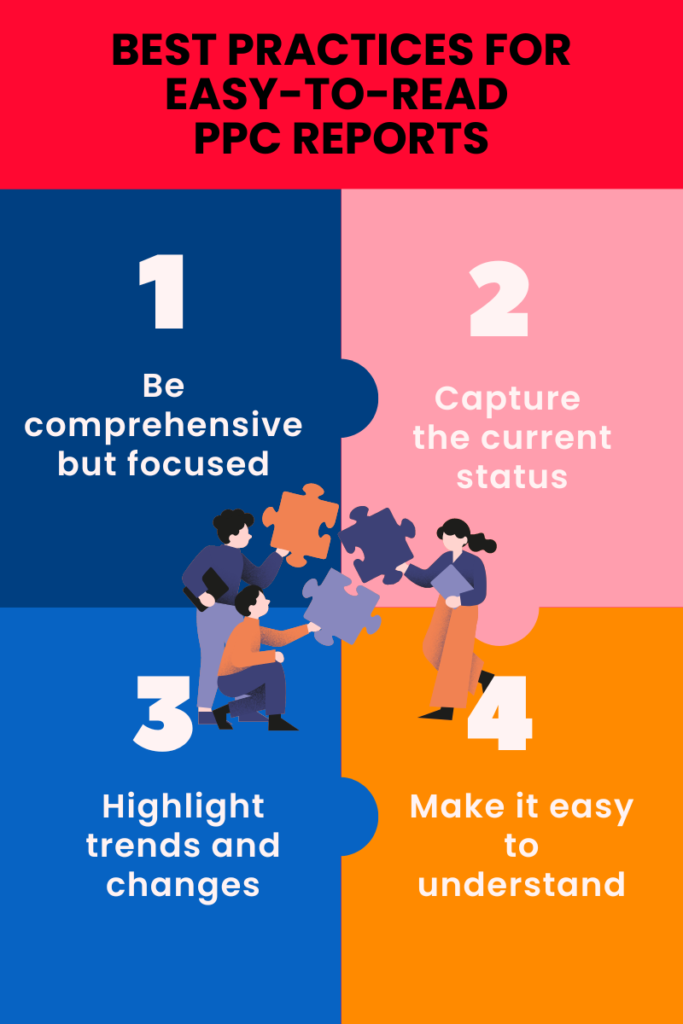OK, you’re hungry for higher results in your ad campaigns. But the B2B digital advertising realm has its villains:
- High costs and low returns
- Data overload
- Attribution complexity
- Competing in saturated markets
- or difficulty in tracking long sales cycles.
And the list goes on. As a marketing manager, you know those bad guys too well, right?
The good news is that we’re here to help!
To optimize PPC campaigns, you need to master your campaign performance tracking. Right here, we covered the foundations of solid PPC reporting. This article will show you how to interpret your reports and double down on PPC optimization.
Are you ready for your PPC optimization checklist? Let’s get to it!
Why PPC Optimization is Essential
Navigating the complexities of B2B marketing is challenging, particularly when you’re dealing with issues like high costs, data overload, and intricate attribution models. That’s why it’s essential to not only understand but also actively optimize PPC campaigns. Let’s delve into why ignoring PPC optimization is a risk you can’t afford to take.
The PPC Optimization Challenges
Navigating the world of PPC campaigns is not without its obstacles. Below, we outline some of the most common challenges that marketing managers face, especially when failing to focus on PPC optimization.
Understanding these pitfalls can provide valuable insights into what you might be doing wrong—and how to get it right for your target audience.
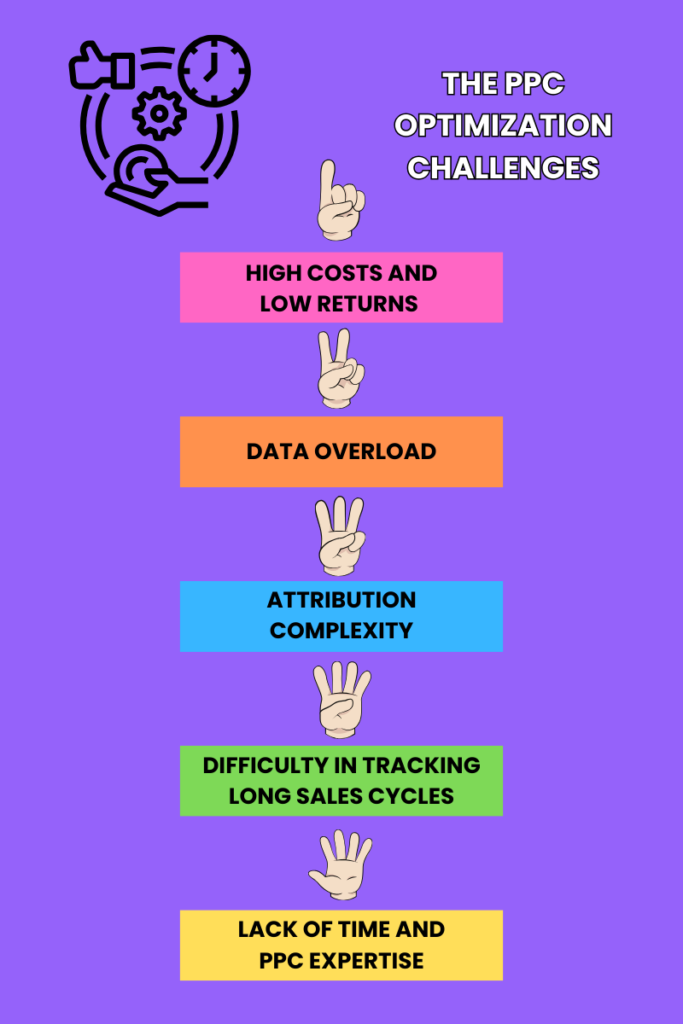
High Costs and Low Returns
Are you grappling with an ever-shrinking ROI on your PPC campaigns? With proper PPC optimization, you can avoid burning through your budget on clicks that don’t convert. Every click truly counts in saturated markets, and missing out on optimization can be costly.
Data Overload
PPC platforms are a treasure trove of metrics, but without optimization, you might be overwhelmed by data that doesn’t move the needle. How do you sift through the noise to focus on what truly matters?
Attribution Complexity
As you know, multiple touchpoints often lead to a single B2B sale. If your PPC campaigns aren’t optimized, figuring out which ads genuinely contribute to conversions becomes a herculean task.
Difficulty in Tracking Long Sales Cycles
The long sales cycles in the B2B world can be a nightmare to track. Without PPC campaign optimization, you risk losing your grip on where prospects are in the funnel, which makes the already complicated sales process even more challenging.
Lack of Time and PPC Expertise
Are you stretched thin with responsibilities? Poorly optimized PPC campaigns can be a time sink, demanding constant tweaks and monitoring.
The Upsides of Investing in PPC Optimization
Before we dive into the specific benefits, it’s important to underscore why taking the time to optimize PPC campaigns can transform your advertising strategy from a resource drain to a powerful asset.
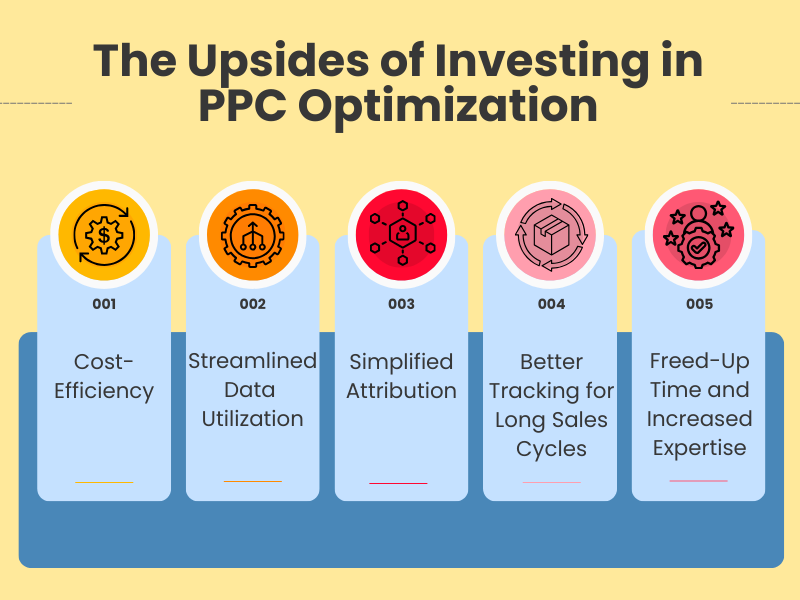
Cost-Efficiency
One of the first benefits of PPC optimization is a more effective use of your budget. Tailoring your ad copy, targeting the proper parameters, and selecting precise keywords allow you to reach your target audience without wasting resources.
Streamlined Data Utilization
Optimized PPC campaigns can convert that overwhelming data stream into actionable insights. It helps you zone in on metrics that matter, resolving the challenge of data overload.
Simplified Attribution
With optimized PPC marketing, the murky waters of attribution become clearer. You’ll better understand which strategies drive conversions, allowing for more intelligent resource allocation and planning.
Better Tracking for Long Sales Cycles
Believe it or not, PPC optimization techniques can be adapted to track long and complex B2B sales cycles more effectively. This enables you to fine-tune your tracking and retargeting efforts.
Freed-Up Time and Increased Expertise
Once your PPC campaigns are optimized, they require less of your constant attention. This frees you up to focus on other pressing tasks and responsibilities.
In short, PPC optimization isn’t just a nice-to-have. It’s a must-have if you want to turn the challenges you face into opportunities for growth and efficiency.
PPC Optimization checklist
Understanding PPC optimization isn’t just about knowing what to do. It’s also about knowing when to do it.
The optimization process can be divided into three crucial phases: before the campaign starts, while it’s running, and after it’s completed.
Let’s delve into these phases to give you a bird’s-eye view of what each entails.
Pre-Campaign PPC Optimization
Market Research
Before launching any PPC campaign, you must grasp your target audience and the market landscape. Market research sets the foundation for a campaign to reach those genuinely interested in your product or service. Don’t underestimate this step. It could be the difference between an ad campaign that resonates and one that falls flat.
Keyword Research
Your ads will fight for visibility on search engines, and the right keywords can give you the edge. Choose them wisely, considering search volume and competition, to ensure your PPC campaign starts correctly.
In-Campaign PPC Optimization
A/B Testing
The work is far from over once your campaign is live. A/B testing allows you to fine-tune your ads by running two versions and comparing their performance. This method enables you to isolate variables and make data-driven decisions, improving your PPC performance.
Ad Copy and CTA Optimization
You’ve got your target audience’s attention; now what? Your ad copy and Call to Action (CTA) are your chance to convert interest into action. Make every word count and optimize your CTA to align with your campaign goals.
Landing Page Optimization
Your ad might be the hook, but your landing page is where the conversion happens. An optimized landing page looks good and is tailored to your target audience’s needs and wants, driving better results.
Post-Campaign PPC Optimization
Analyzing Metrics
After concluding your campaign, moving on to the next one is tempting. But first, it’s crucial to dive into the data. Understanding key metrics, like click-through and conversion rates, can offer insights into what worked and what didn’t.
Ongoing Optimization Strategies
Your job isn’t done when the campaign ends. Use the insights gained to optimize your PPC for future campaigns continually. Learning from past performance data allows for more effective planning and strategy for your upcoming ad campaigns.
By focusing on these critical elements at each stage of your PPC campaign, you’ll be better equipped to optimize your PPC efforts, achieve better results, and hit those all-important campaign goals.
But speaking of metrics – let’s circle back to analyzing your PPC reports and leverage data to optimize your PPC performance.
Make Sense of Your PPC Reports
Spot Key Trends and Opportunities
Recognizing critical trends in your PPC reports is like reading a compass for your advertising campaigns. Look for connections between increased ad spending and a bump in customer acquisitions.
Remember to account for factors like seasonality, pausing ads during slower periods, and ramping up during peak seasons. Weekly trends also matter. If activity dips on Fridays and over the weekends, consider adjusting your ad spend accordingly.
Focus on identifying your most responsive audiences and invest in them. Remarketing often yields excellent results, so consider allocating a larger budget for these campaigns. Pay attention to location; targeting economically developed regions can be more cost-effective. Lastly, compare different campaigns side by side to understand what’s driving conversions.
Measure Your Wins and Learn from Your Hiccups
Success in PPC advertising isn’t just about numbers. It’s about impact—both direct and indirect. Good ROI or low CPA could be immediate signs of campaign success but don’t overlook the incremental benefits that PPC can bring, such as brand awareness that converts through other channels like SEO or affiliate links.
However, especially when promoting SaaS solutions, you could encounter some pitfalls.
Here are some common shortcomings to be aware of:
- Targeting Too Broad an Audience: Focusing on a mass audience when your product serves a specific niche can dilute your message and impact. Broad-match keywords in search campaigns might not yield the particular audience you desire.
- No Test Offers: Potential customers may be turned off if you’re only offering a buy option without any trial period. People often want to 'try before they buy.’
- Complex Pricing: A complicated pricing model can confuse potential customers and lead them to abandon purchasing. Simplify your pricing strategy wherever possible.
- Ignoring Seasonality: Failing to adjust your ad spend and campaign offers according to seasonal trends can result in missed opportunities or wasted budgets.
- Prolonged Poor-Performing Campaigns: Continuously running campaigns that yield poor results is a waste of resources and a missed opportunity for optimization.
- Lack of Optimization: Failing to update and optimize your campaigns continually can result in diminishing returns over time.
- Insufficient Educational Content: Neglecting to include content that educates potential customers about your product’s features, benefits, or novelty can result in a weaker sales pitch.
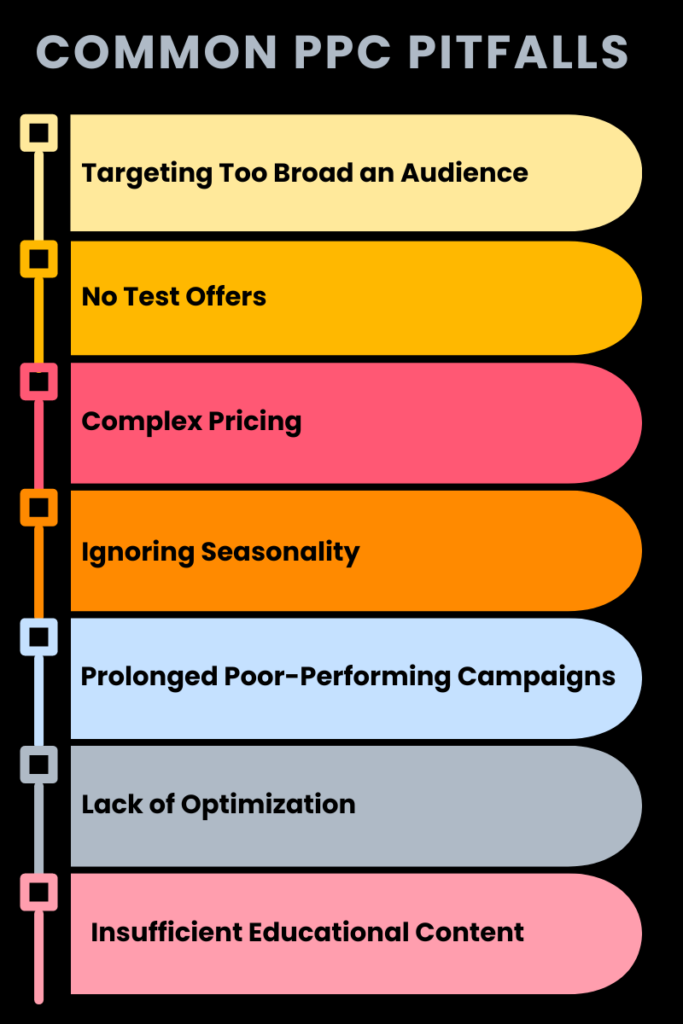
By being aware of these potential shortcomings and actively working to avoid them, you’re setting the stage for more effective, impactful PPC advertising.
Guide Your Strategy with Data-Driven Decisions
It’s simple to invest more in your PPC campaigns when the ROI is high, or the cost-per-conversion is low; these are indicators of a successful strategy. Similarly, it’s easy to recognize when it might be time to pull the plug on a campaign that’s been underperforming for an extended period, like three weeks. The challenge comes in when the results are mixed.
Suppose you find yourself in this 'gray area,’ where you’re attracting customers, but the costs are high, or traffic is increasing without a subsequent rise in engagement or conversions.
When faced with such a situation, it puts your decision-making skills to the test.
In such cases, consider the following steps:
- Refine Advertising Elements: Keep only the top-performing PPC ads and pause or retire the less effective ones.
- Revise Landing Page Content: Think about refreshing the language and offers on your landing pages to communicate the benefits of your product or service more effectively.
- Price Comparison: Evaluate whether your pricing is competitive enough or if it’s turning potential customers away.
- Seek Customer Feedback: Occasionally survey your audience to understand what drives their decision to buy or not. This insight can be invaluable.
- Interdepartmental Collaboration: Consider meeting with customer support, sales advisors, and others who have front-line interactions with customers. They may offer insights into barriers to transaction completion that aren’t immediately obvious in the advertising data.
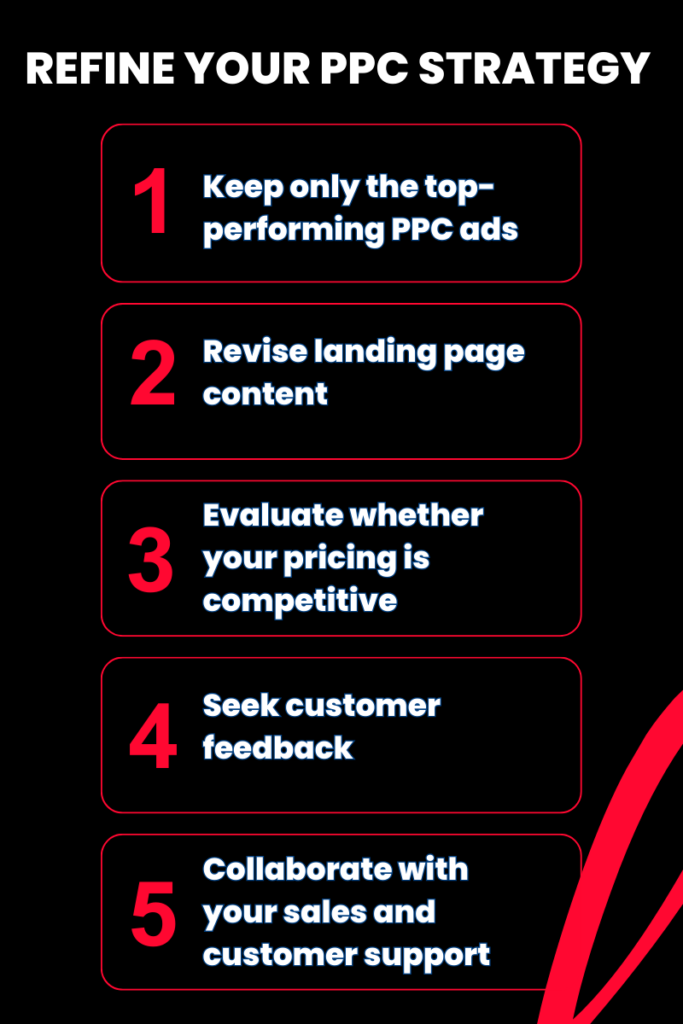
Remember, the issue may not solely reside in your PPC advertising efforts. External factors like:
- payment issues,
- unclear product descriptions,
- legal roadblocks… could affect your campaign performance.
Optimizing PPC Performance with Data-Driven Insights
Master Keyword Optimization
To bolster your PPC campaigns, a strong keyword strategy is indispensable. Here are some proven tactics to consider:
- Preserve High-Performing Keywords: Retain the keywords that consistently generate conversions and gradually phase out underperforming ones.
- Keyword Match Types: Tweak your match types based on performance. Use exact match for high-converting terms, and phrase match for mid-level performers, and broad match for keywords where you’re exploring potential.
- Ethical Keyword Practices: While tempting, using competitors’ brand names as keywords is generally considered unethical and risky from a legal perspective.
- Mine Search Terms Reports: Routinely check the „search terms report” for new keyword opportunities to fold into your campaigns.
- Branded Keywords: Don’t underestimate the power of your brand or product name; these often drive high conversions.
- Low Competition Keywords: Seek out keywords with low advertising competition but potential for high impressions and traffic.
- Mobile-Only Keywords: Single-word keywords can often be more effective for mobile campaigns.
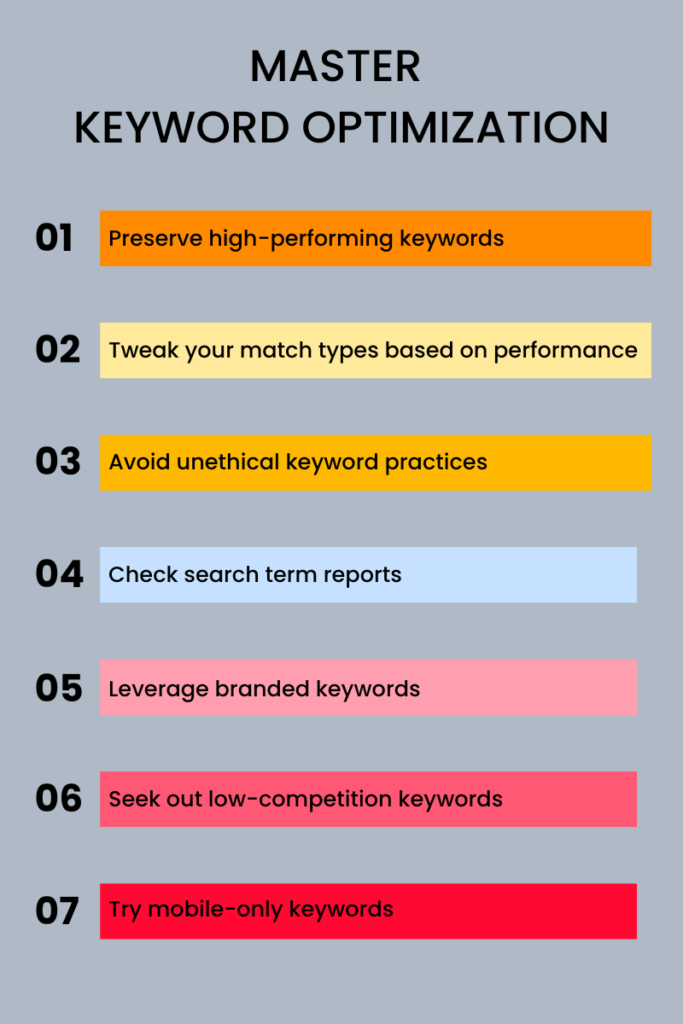
Elevate Ad Copy and Landing Pages
Quality ad copy and landing pages can significantly impact your PPC results. Here’s how to keep them optimized:
- Dynamic Ad Copy: Best practices recommend running at least two, but no more than four, text ads simultaneously to compare effectiveness. Keep the top-performing ones and retire or modify the weaker PPC ads.
- Landing Page A/B Testing: It’s essential to conduct A/B tests on your landing pages to identify which performs better. Aim to guide users down the sales funnel, starting with informative content like blog articles or case studies and eventually leading them to dedicated product pages.
- Frequency of Updates: While there’s no one-size-fits-all answer, regular check-ins are crucial to gauge performance and make needed adjustments.
Fine-Tune Your Budget Strategy
Understanding the ups and downs of your industry’s seasonal trends can set you up for budgeting success.
In prosperous economic times, consider amplifying your advertising expenditure to capitalize on favorable market conditions.
Some argue that advertising isn’t necessary when customers are already flocking in, but this perspective may limit your reach. Investing in advertising opens doors to a broader audience and potentially elevates customer acquisition numbers.
When dividing your annual ad campaign budget, don’t simply split it into 12 equal parts each month. Instead, adapt to the changing landscape: consider boosting your budget by as much as 100% or more during peak seasons. Conversely, you should cut back by 60-80% in weaker months.
Of course, these numbers aren’t set in stone. The key is to remain flexible, adjust to your situation, and continuously monitor your ROI and ROAS.
When these indicators remain positive, it may be a good sign to incrementally increase your campaign budget to capture even more value from your campaigns.
Wrapping It All Up
PPC campaign optimization can feel like a puzzle, but it’s easier to solve than you think. This guide showed you how to spot PPC marketing opportunities, learn from failed ad campaigns, and how to optimize PPC performance.
We’ve covered it all to help you make confident, informed decisions that could boost your business.
If this still feels too much, don’t worry—you’re not alone. Our friendly team is here to help. We can handle the PPC reports and even your entire campaign, giving you more time to focus on what you do best.
Interested? Let’s chat. Book a call today, and we can start making your PPC work harder for you.
ps. And check out other articles on Cayenne Flow’s blog.


